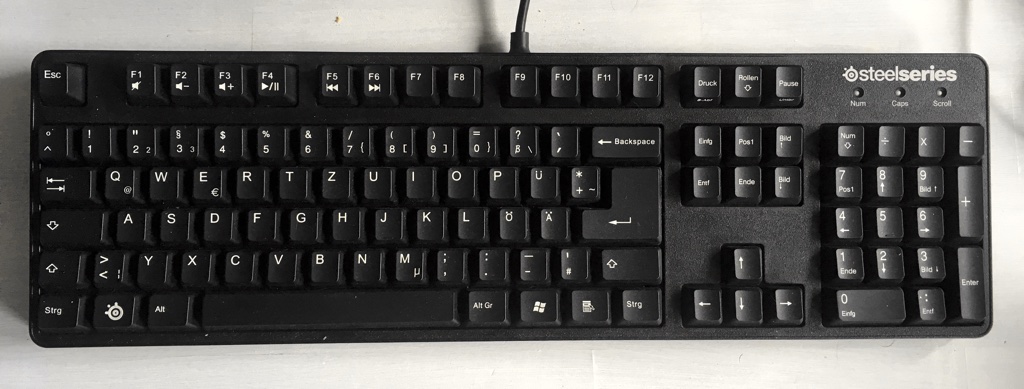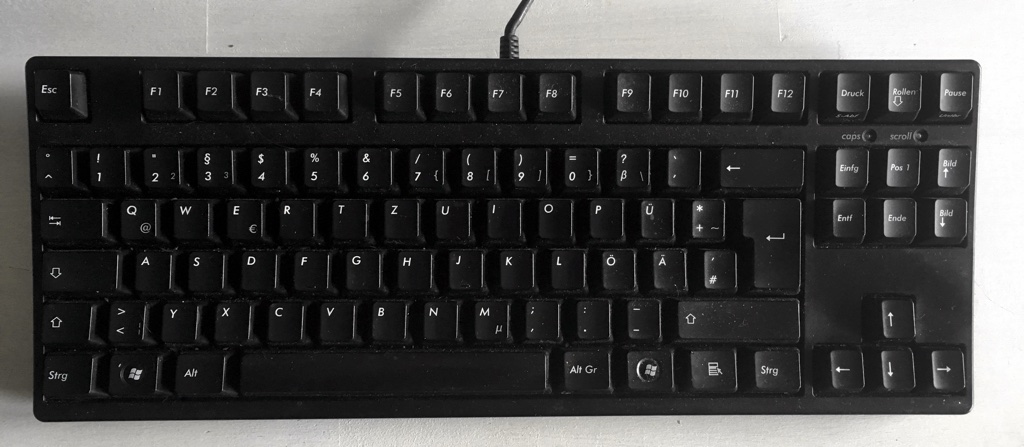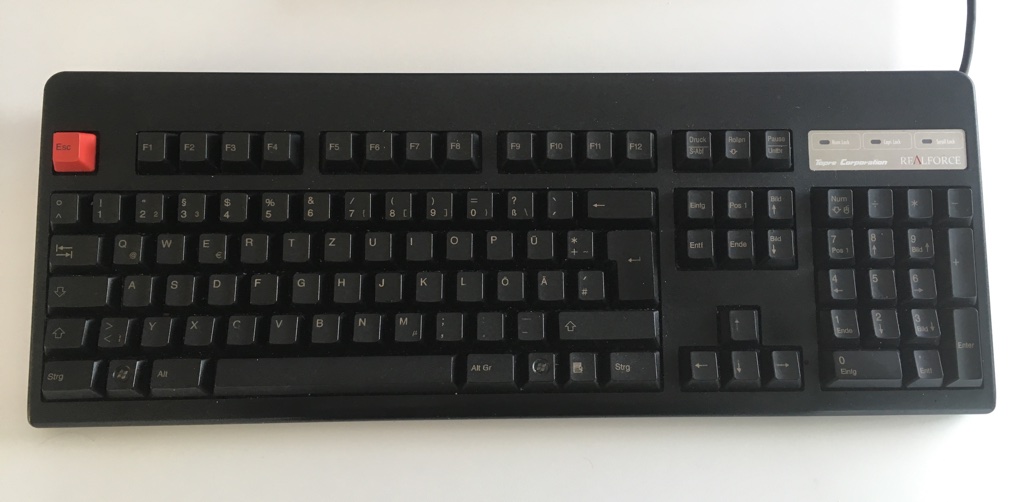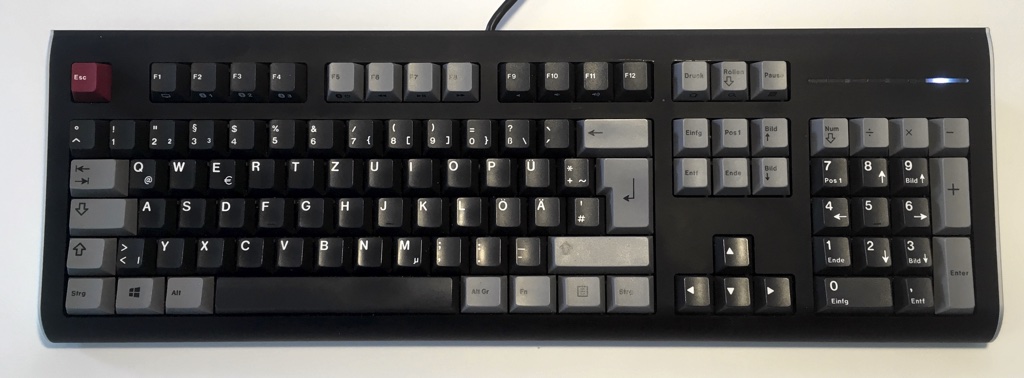History
During the past years mechanical keyboards have been re-appearing at the consumer IT market. While by far most keyboards sold and used are based on a membrane (“rubber-dome”), especially the gaming industry established keyboards with mechanical switches as a “new” gold standard for input devices. Looking back in the history of personal computing, such mechanical keyboards were the norm until the late 1990’s and got replaced by much cheaper, less complex and more light-weight rubber-dome desktop and scissor-style laptop keyboards during the 2000’s. While for laptops, the “thin and flat” paradigm was and is the reason to integrate such keyboard, the reason to use them at desktops and workstations was simply the race to the bottom of cost.
The lower tier of desktop computing did suffer a lot from tablets and notebooks, entry-level users rather opt for a cheap notebook than for a clunky stationary computer with peripherals. The market which continued to expand is gaming, government and professional grade workstations - rather expensive machines. However, even though enthusiasts spend a fortune on powerful GPUs, complex case-mods and electricity, peripherals like screens and keyboards were not considered to be relevant for a long time. The same is true for professional users. Employers provide high-end workstations well above the range of €5000 but equip it with a €200 screen and a €20 keyboard+mouse combo that lasts two years. At the first glance, this makes sense from a business side since broken peripherals can be replaced with low maintenance effort.
Health
In reality however peripherals which are already past their lifespan continue to be used for a long time, with disastrous impact on health and productivity. When thinking about how much time one uses such peripherals, ergonomics and hygiene are a extremely relevant but often ignored fact. Losing productivity at the end of a working day or even getting sick due to finger fatigue or bad eyesight has huge productivity impact. One would expect that employers realize this and start investing in proper peripherals, which is quite the opposite of expensive when looking at productivity gain. High-quality screens, mice and keyboards can outlast typical upgrade-cycles of computers many times, so on the long run it may even be financially cheaper to invest into proper peripherals.
Going mechanical
Fortunately the mindset and product ranges started to change some years ago and manufacturers expanded their portfolio with mechanical keyboards, ergonomic mice and great screens again. While this kind of equipment never really vanished at the government sector, to most PC users it appears as something entirely new. Now what makes a keyboard mechanical? There are lots of in-detail articles on the web about this topic so lets keep it brief:
“A mechanical keyboard uses some kind of electronic switch that get actuated by the force of a key press. Rubber-dome keyboards rely on actuating a rubber membrane to close a electronic circuit when pressing a key.”
In theory this sounds like a marginal difference but the practical difference is like comparing a Ford Model T to a Tesla Model S. Manufacturers did realize that people are willing to spend a multitude of money on a good mechanical keyboard compared to a rubber-dome keyboard. This did not only led to greater choice of mechanical keyboards but also allowed those manufacturers to differentiate by adding features, premium materials and actually invest into research instead of just throwing the same damn product on a dead low-margin market where the only differentiation is a brand name.
Regardless of features like connectivity, back lights or media keys, the main ingredients for a good mechanical keyboard are its switches and key caps. When moving to mechanical keyboards its perfectly normal to feel a bit more fatigued in the beginning since pressing a key usually requires more force. Rubber-dome veterans are used to bottom-out their keystrokes, which is not necessary on a mechanical keyboard but adds to fatigue. This is however temporary and gets diminished for the more pleasant typing feedback in the long run and getting used to the characteristics of a mechanical keyboard.
Of course there are many subtypes, yet there are some general characteristics:
Rubber-dome
- Usually require to bottom-out the key press to actuate, soft feedback
- Hard “confirmation” of the key press when hitting the bottom PCB layer
- Low lifespan when using it many hours a day
- Inconsistent typing feedback once the rubber wears out
- Usually “pad printed” or “laser etched” key cap legends that wear out quickly
- Hard or impossible to clean or change key caps, no real choice in caps
- Cheap build quality of key caps and case due to overall low price point
- Price point: €10 - €80
Mechanical
- Consistent “actuation” point which does not require to bottom out, very precise and spot-on feedback
- Optional characteristics like “tactile” (feel the actuation point) and “clicky” (acoustic feedback of the actuation point)
- Long lifespan, typically 30-50 million keystrokes per key (~20 years at 8 hours usage 5 days a week)
- Premium key cap materials (ABS, PBT) with robust legends (dye-sublimation, double-shot)
- Translucent key caps and switches which allow back light, color LED effects
- Different types of key caps, which can be removed, cleaned, replaced and customized
- Overall better build quality due to higher price point, more rigid quality control
- Price point: €60 - €350
Financials
Spending more than €200 on a keyboard is certainly a bit excessive and can’t be justified financially when looking at it from a neutral point of view. For some people however mechanical keyboards are a “hobby” and even “collectors items” when thinking about vintage or rare keyboards or artisan key caps. There are great mechanical keyboards at the sub-€100 range, especially from gaming peripherals makers. Those really expensive keyboards usually target the typists and software development community - people that type for a living.
When discussing the cost of mechanical keyboards, it has to be noted that both switches and high quality key caps are very expensive - and a keyboard needs 100+ of them. The next cost driver is the fact that most keyboards are using a 104-key ANSI layout. If you’re used to a 105-key ISO layout there is a good chance to either pay a premium for “exclusivity” or just not getting ISO-style keyboard off the shelf at all. As an example, a full set of high quality ABS double-shot or PBT dye-sublimated key caps costs €100+ alone, add €0,50 per switch, electronics, cables, casing. Last but not least high-end keyboards are not a mass-market product that get produced by the millions. All this puts a €100+ price tag for a keyboard into perspective, another way to view it is: Good keyboards cost good money, we just got used to low quality cheap keyboards.
Switches
There are two major types of mechanical switches: “Cherry MX” made by Cherry GmbH in Germany and “Topre electrostatic capacitive” made by Topre Corporation in Japan. Several clones of those switch types are being manufactured but should be avoided since they usually don’t get made with same amount of precision and quality requirements. Other less common switch types, like ALPS or vintage “buckling spring”, are built with different specification. Such specifications define the actual switch characteristics, the housing dimensions as well as the stem and key cap mount format. While Cherry MX have “+”-type stems, Topre have “o”-type stems which are incompatible to each other - with the exception of special-made stems for Realforce RGB and Novatouch (discontinued) keyboards that fit both key cap mounts. On top of these stems sits the actual key cap made of plastic, which is usually removable. A word on big numbers - it does not matter if a switch has a projected lifespan of 30 or 50 million keystrokes, in either way it will easily outlive the case, keycaps or even the connector. Try finding a recent computer with AT or PS2 connectors which were used 20-30 years back.
Cherry MX are traditional switches with a spring that requires a certain force to compress and move parts into place to close a electric circuit. Depending on the type (MX “color”), switches are either tactile or linear, clicky or silent. Their basic concept stays the same though. Topre is a very different story, in fact they are more rubber-dome than mechanical. The tactile feedback when pressing a key is provided by a high quality rubber-dome and beneath that dome a spring gets compressed. The spring is however not used to provide force but to indicate capacity. Beneath the spring a sensor registers the electrostatic capacity of the compressing spring and once a threshold is passed a actuation is registered. No traditional “mechanical” switch is used which is good for durability since the system is more “sealed” and suffers less from friction. The typing characteristics and durability are similar to a Cherry MX Brown (tactile, silent) but again completely different. Pressing a Topre switch feels more like pushing a piece of metal through a magnetic field and the push-back when releasing the key is significantly “different”. That being said, both switch types provide a extraordinary typing experience. Before spending lots of money on a new switch type though, definitely consider getting a sample switch or switch-tester to evaluate.
Reviews
Over time i bought several mechanical keyboards for different use-cases, so far none of them did break or has ever shown severe issues. This naturally reduces the amount of items i could compare.
- Steelseries 6Gv2
- Filco Majestictouch 2 TKL
- Topre Realforce 105UB
- Uniqey Q100
Disclosure: I bought all those boards from my own money and did not get any sponsored samples for review, neither has any of the manufacturers contacted me.
Steelseries 6Gv2

The 6Gv2 is a full-sized keyboard priced at an entry-level €70 and aims for the gaming community. It uses plate-mounted Cherry MX Black switches (rated at 50M keystrokes) which are “linear” meaning the actuation point can’t be felt when pressing a key. Resistance to the key is 60 grams which makes it a bit harder to press but also reduces unintended key presses. The case has a acceptable build quality and weights in at about 1.3 kilograms, big rubber feet make sure it stays in place like its glued to the table.
When using a USB-to-PS2 Adapter, and assuming the computer still offers a PS2 port, this keyboard allows n-key-rollover (“NKRO”) which means actuation of all 105 keys can be signaled to the computer at the same time. USB is limited to 6KRO by design on the other hand. The keyboard comes with a 2 meter non-detachable rubber USB cable, PS2 adapter and can be tilted.
Overall the keyboard is basic in functionality but does a great job when gaming is a priority - for typing and fatigue-reduction there are better alternatives though. The key caps start to get shiny after a few years and the white color at the laser-etched legends starts to fade. Since the cost-benefit ratio is excellent, its a great keyboard to get into the mechanical keyboard experience.
Filco Majestictouch 2 TKL

This is a premium (IMHO overpriced) €150 ten-keyless keyboard (“TKL”) which means the numblock is missing to make it more compact. While this might be a deal breaker for typists its great for gaming since the mouse-hand is much closer to the keyboard-hand which reduces fatigue. Most games won’t need the numblock anyway. The Majestictouch is available with different plate-mounted Cherry MX keys (Brown, Black, Blue, Red) which translates to different characteristics that can be looked up easily on the web. The build is very sturdy, despite its compact size and 88 keys it weights about 1 kilograms and has great rubber feet that fix it to the desk.
Just like the Steelseries it supports NKRO when using PS2, has a non-detachable rubber USB cable as well as the ability to be tilted. Key caps are made of ABS with laser-etched legends and are of good but not outstanding quality since they wear out after some years, especially when using the “WASD” section excessively. The cost-benefit ratio is quite bad compared to the Steelseries and it only makes sense when specifically looking for a nicely built ten-keyless Cherry MX gaming keyboard without any fancy features. On the other hand ten-keyless layouts are a niche configuration within a niche product range, which makes them even more exclusive and counting keys to justify the price does not take that into respect.
For personal preference i use the Cherry MX Brown switch option (tactile, non-clicky) of the keyboard. With regards to noise this is a good example how switches do affect noise but are not the only factor to take into consideration. Compared to other MX Brown keyboards, the Filco Majestictouch is much louder during typical use. This is caused by inherent keycap “rattling” and quite loud clicks when bottoming out the keys which is related to the material and quality of the keycaps. If i’d to chose again i’d probably go for a Corsair K65 which offers a similar form factor and quality for half the price.
Topre Realforce 105UB

Topre Corporation makes keyboards using their proprietary electrostatic capacitive switches, rated at 30M actuations. The “Realforce” brand is their high-end keyboard series which targets business users. While there are ten-keyless options and even numblock-only devices available, the “full-size” 104 or 105 key models with standard layout are most popular. There are few distributors and a ISO layout is rather hard to find. As described earlier the typing experience is one of a kind due to the specific switch characteristics. The keyboard is made of high quality plastic, including key caps made of PBT instead of ABS. PBT is more durable and less prone to getting shiny over time. The keys legends are dye-sublimated since there currently is no way to make double-shot PBT key caps and the space bar is made of ABS since large PBT key caps are also hard to manufacture. However, there are replacement space bars made of PBT available.
The Realforce comes with a solid 1,5 meter non-detachable rubber USB cable and some cable routing tunnels beneath the board, it can be tilted as well. Its weight of 1,5 kilograms and two rubber feets at the bottom make sure that the keyboard stays in place quite well. A nice feature is variable actuation weight, which makes sure keys usually triggered by less dominant fingers require 35 or 45 grams while more dominant fingers have to overcome 55 grams for their keys.
The overall build quality is flawless and as good as a plastic product could possibly be. So far i use this keyboard 8 hours per day at most days of the week for 6 years straight, it did never let me down and is a real workhorse. The only thing i noticed is that macOS sometimes does not recognize the keyboard after getting back from hibernation and i had to unplug/plug it in again. Over time even those PBT key caps got a bit shiny and some often-used keys start to fade. However, considering the heavy usage its the most durable keyboard i came across so far. The asking price including taxes and shipping from England is €260 in Germany, which is quite an investment.
Just recently Topre introduced the “Realforce RGB” keyboard which is more gaming oriented and sacrifices some of the typical Realforce features (like PBT keycaps) for more stylish things like illumination which requires ABS keycaps with shine-through legend. I had the opportunity to check it out for some minutes and if budget is not a limitation this would be a natural choice for a great gaming keyboard. The electrostatic capacitive switches allow a unique feature which is per-key actuation point configuration since the actuation is determined by measuring capacity instead of a mechanical switch. Illuminated keyboards are not my thing so i’d rather swap the ABS keycaps that come with it with some PBT caps which is easy since the Realforce RGB comes with key stems that are compatible to both Topre and Cherry MX keycaps. If only they would make a ISO layout of the RGB…
Uniqey Q100

The Uniqey Q100 is the latest addition to my collection and appears to be pretty much unknown on the Internet and particularly among reviewers. The brand just started shipping their keyboards in late 2016 and is backed by the german industrial equipment manufacturer “GMK electronic design”, well respected for their high-end keycaps. Besides offering some pre-configured keyboards, their unique selling point is customization and their high quality double-shot ABS keycaps. ISO and ANSI layouts are offered whereas sections of the key layout can be customized with different colors and legends. Uniqey offers the full range of PCB-mounted Cherry MX switches and adds their own “QMX-Clips” as an option which reduce the noise of a key press significantly. Note that those are far better than rubber o-rings, which heavily influence typing feedback. The biggest difference to other keyboards are the materials used for the keyboards case. Every Q100 is made of a anodized aluminum body and can be customized with side-panels made of wood or anodized aluminum.
While other keyboards are said to be built like a tank, the Uniqey Q100 literally IS a tank. Its made of metal and weights 1,5 kilograms, has modular detachable rubber feet, a highly flexible detachable Micro-USB cable for power supply and data and offer a auxiliary USB port to connect mice. On top of USB connectivity it comes with an integrated Bluetooth module which allows to type on three different devices like tablets, phones and laptops and can easily switch the paired device on the fly. I opted for Cherry MX Brown (tactile, non-clicky) switches and added QMX clips, combined with the sturdy build quality and thick ABS keycaps typing is extremely silent even when bottoming out keys. By choosing switches with specific charactersitics the Q100 can be configured to be a perfect typing keyboard or a great gaming keyboard.
While using the keyboard for multiple months i could not find any downside of this product, its a truly remarkable piece of engineering and a prime example for quality stuff “Made in Germany”. That being said the price is just as remarkable with €265 to €338 depending on configuration. However, the product delivers just perfectly, after a few minutes one will understand why this thing costs as much as a entry-level laptop. It operates perfectly and the look and feel comes very close to the enclosure of a Mac Book Pro or comparable high-end devices. At the same time its visual appearance is very unobtrusive due to the absence of illumination and brand logos. In my personal opinion the Uniqey Q100 provides a better overall package than any other keyboard i have used, including the best-of-the-rest: Topre Realforce.
Conclusion
As always there is no “best” product but if budget is not a concern and you’re looking for the ultimate keyboard then figure out your preferred switch type, get a Uniqey Q100 or Topre Realforce and look no further. If fanciness is what you’re into, get a Topre Realforce RGB. If you’re on a budget or uncertain if mechanical keyboards are a thing for you, get a Corsair K65 or Steelseries G6v2. In any way, the typing experience and impact on health will be worth the investment, especially if your occupation means a lot of typing.